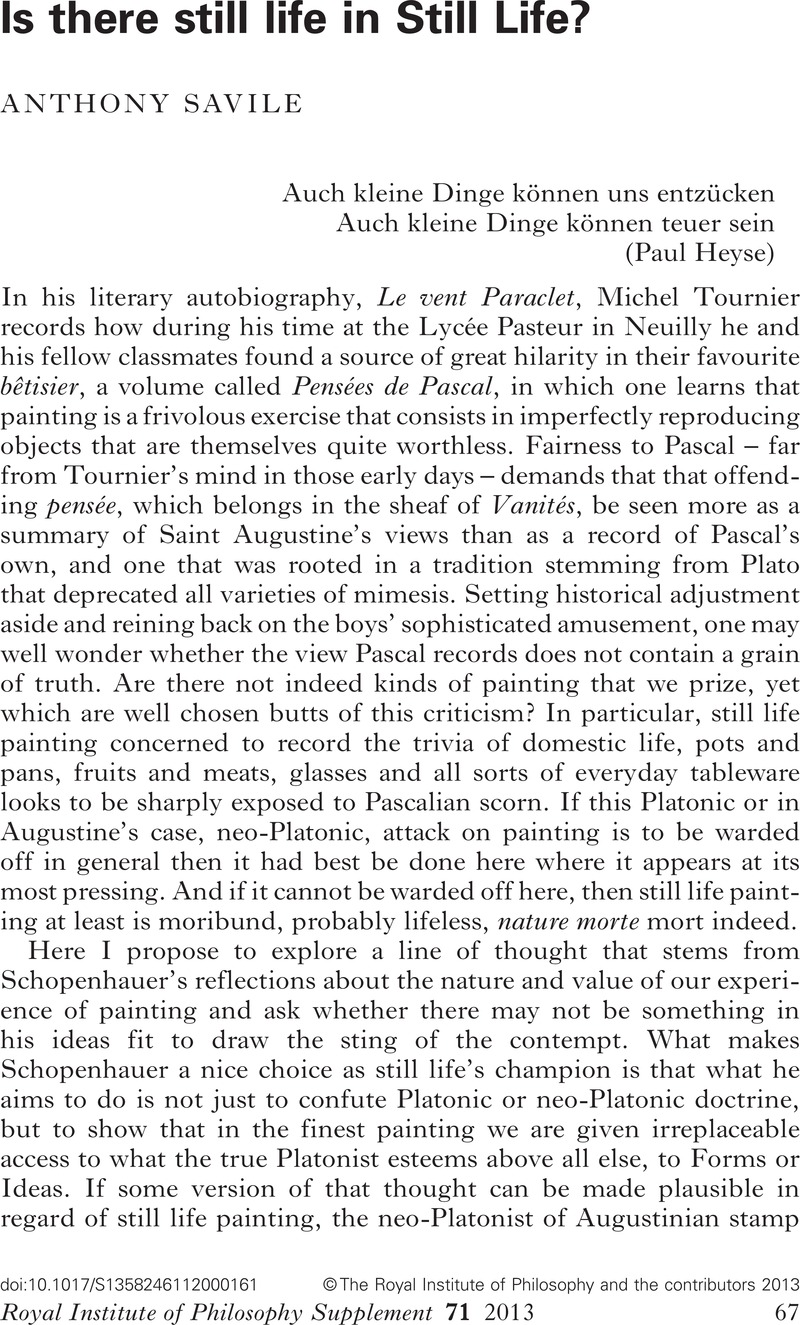No CrossRef data available.
Article contents
Is there still life in Still Life?
Published online by Cambridge University Press: 11 March 2013
Abstract

- Type
- Papers
- Information
- Royal Institute of Philosophy Supplements , Volume 71: Philosophy and the Arts , October 2012 , pp. 67 - 84
- Copyright
- Copyright © The Royal Institute of Philosophy and the contributors 2013
References
1 Bryson, Norman, Looking at the Overlooked, (Reaktion Books, London, 1990), 64Google Scholar. My illustrative examples are all to be found in Bryson's book, and I have made free use of some of his incisive commentary.
2 See Bryson, op. cit. note 1, 72.
3 That we properly see those pots metaphorically as people, in the way Christopher Peacocke has recently suggested (British Journal of Aesthetics, 2009). strikes me as fanciful and out of keeping with the picture's seventeenth century spirit. That is not to say that they cannot be so seen.
4 The idea surfaces in §49 of the Critique of Judgment and is prefigured there in §23.
5 Maybe this is a point at which to sympathize with Walt Whitman's ‘Do I contradict myself? Very well, then, I contradict myself. I am large. I contain multitudes’.
6 The locus classicus of this thought is Proust's early essay ‘Chardin et Rembrandt’, one to which writers on Chardin regularly recur (Proust, Essais et Articles, ed. Laguet, T., Gallimard, Paris, 1994, 68–78Google Scholar). The contrast between forgetting and overlooking is important. We can only forget what has already occupied the mind, whereas what we overlook does not touch it. In a brief comment on Proust Richard Wollheim has suggested that the pleasure we come to find in domesticity and which we derive from Chardin is not something that we had previously overlooked but something that had not been consciously within our grasp. It is a quality which can be retrieved from unconscious awareness (which is where Prost locates it) only by our having looked at Chardin, by having looked at representation (Painting as an Art, Thames and Hudson, 1987, 99).
7 ‘Le Problème des musées’ in Pièces sur l' Art, Paul Valéry, Oeuvres, La Pléaide, Vol 2, 1290–94. Valéry was not the first to view museums askance. Sixty years or so before Ruskin had spoken of them as ‘places of execution of pictures’ (‘A Joy Forever’, §93).
8 In Praeterita Vol. II, §197. See too §94 of A Joy Forever : ‘But great good is also to be done by encouraging the private possession of pictures; partly as a means of study (much more being always discovered in any work of art by a person who has it perpetually near him than by one who only sees it from time to time) and also as a means of refining the habits and touching the hearts of the masses of the nation in their domestic life’.
9 In his own words, ‘Je crois bien que les hommes doués pour concevoir, et nés pour créer ne manquent jamais; mais il leur manque souvent – il leur manque singulièrement aujourd'hui, . . . . ces amateurs et connaisseurs incorruptibles, chez lesquels ni l'espoir de faire une bonne affaire, ni la prestige de la plume, ni l'ambition de précéder ou de suivre la mode ne troublaient la poursuite de leur volupté personelle et l'exercise de leur intelligence originale’ (from the Préambule to the catalogue of the 1935 Paris Exposition de l'Art Italien, ibid., 1346).
10 I am grateful to Mr.David Woods for pointing out how little sympathetic Plotinus, the arch neo-Platonist, was to the style of criticism from which I started out and in consequence how the view that Pascal records should not be called neo-Platonist in an unqualified way. In particular he drew my attention to Enead V, Tractate 5, Section 1. “Still the arts are not to be slighted on the ground that they create by imitation of natural objects; for, to begin with, these natural objects are themselves imitations; then, we must recognise that they give no bare reproduction of the thing seen but go back to the ideas from which Nature itself derives, and, furthermore, that much of their work is all their own: they are the holders of beauty and add where nature is lacking. Thus Pheidias wrought the Zeus upon no model among things of sense but by apprehending what form Zeus must take if he chose to become manifest to sight.”




